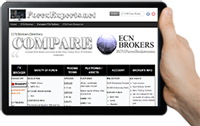
💱 Trading the Forex Market Sentiment
Market sentiment measures what most traders expect regarding the market’s future direction.
Explaining Forex Market Sentiment
Forex market sentiment reflects the overall mood and psychology influencing price fluctuations, with a strong focus on the US Dollar because of its global dominance, status as the world’s reserve currency, and key safe-haven role. Knowing if traders are optimistic (bullish), pessimistic (bearish), or undecided (neutral) about the USD—and understanding the reasons behind this sentiment—is essential for analyzing price trends in major currency pairs, spotting potential market reversals, and making smart trading choices. Essential tools for assessing this sentiment include the COT report, risk reversals, and price action analysis.
- Market sentiment refers to the overall psychology of the market. It can be bullish, bearish, or neutral.
Exploring the Role of the US Dollar
Since the USD is involved in 80% of all Forex transactions, Forex market sentiment mainly focuses on the US Dollar.
🔺 When the USD is Bullish:
-
Impact: There’s strong demand to buy the USD. This leads to declines in pairs such as EUR/USD and GBP/USD, while pairs like USD/JPY and USD/CHF tend to rise. The US Dollar Index (DXY) usually trends upward as well.
-
Explanation: This is often driven by strong economic reports from the US—like GDP growth, employment data, and inflation figures—alongside a Federal Reserve signaling interest rate hikes. Global uncertainty or geopolitical tensions also encourage investors to seek safety in the USD. Additionally, weakness in key US trading partners (such as the EU and China) supports this trend.
🔻When the USD is Bearish:
-
Impact: The USD faces selling pressure. Consequently, EUR/USD and GBP/USD generally increase, while USD/JPY and USD/CHF fall (noting that JPY and CHF are also considered safe-haven currencies). The DXY tends to move lower.
-
Explanation: This sentiment emerges from disappointing US economic data, a dovish stance from the Fed suggesting rate cuts or pauses, a general appetite for riskier assets worldwide, solid economic performance by US trade partners, and worries about US fiscal and trade deficits.
(-) When the USD Outlook is Neutral:
-
Impact: The market lacks a clear trend, often trading sideways. Investors wait for key data releases or significant events to gain direction.
-
Explanation: Mixed economic results, the Fed’s cautious approach, an absence of major risk factors, and typical seasonal slowdowns lead to this indecision.
Methods and Indicators to Assess Forex Sentiment
-
Commitment of Traders (COT) Report: Published weekly by the Commodity Futures Trading Commission (CFTC), this report details how major players—commercial and speculative traders—are positioned in USD futures. When speculators hold extremely net long or short positions, it can signal market sentiment extremes and potential turning points.
-
Risk Reversals (Foreign Exchange Options): This indicator compares the implied volatility between out-of-the-money call options and put options. If the market prices a higher premium for USD calls, it reflects a bullish expectation; a higher premium for puts indicates a bearish bias.
-
Retail Trader Sentiment: Some brokers reveal data on the percentage of retail clients who are long or short a currency pair. Often, retail traders move opposite to the larger trend, so extreme retail positioning might predict a reversal (for example, if 80% of retail traders are long EUR/USD, a downward correction might be imminent).
-
Price Movements and Technical Indicators: Trends, chart breakouts, and specific patterns often mirror the prevailing sentiment. Strong and consistent price moves usually confirm market confidence.
-
Sentiment from News and Social Media: Automated tools analyze the tone of news reports and social media conversations related to the USD, helping to measure whether the sentiment is predominantly positive or negative.
-
Volatility Metrics (VIX and FX Volatility): The VIX measures expected volatility of the US stock market and often spikes during times of risk aversion, which typically strengthens the USD. Dedicated FX volatility indices also provide insight into currency market uncertainty. More info here: https://currenciesfx.com/index.php/forex-library/other-markets/trading-the-vix
These are some additional Forex Market Sentiment indicators:
- Open Interest (Currency Futures)
- Put/Call Ratio (Currency Futures Options)
General Market Sentiment Tools
Here are some popular Forex market sentiment tools available online:
■ Dukascopy Market Sentiment Tool
https://www.dukascopy.com/swiss/english/marketwatch/sentiment/?ibref=8411
■ FxStreet Market Sentiment Tool
https://www.dailyfx.com/sentiment
■ FXCM Speculative Sentiment Index (SSI)
https://www.fxcm.com/services/forex-trading-tools/ssi-speculative-sentiment-index/
Commitment Of Traders (COT) Report
The COT report is published weekly by CFTC and provides traders with detailed information about the opened positions in the US futures market. Here is a link: www.cftc.gov/cftc/cftccotreports.htm
The COT Report presents three categories of opened positions:
- Commercial (Not-Important)
Positions of traders who use futures contracts for hedging against market risk.
- Non-commercial (Very-Important)
Positions of participants who speculate the market, such as investment banks, hedge funds, etc.
- Non-Reportable (Not-Important)
Positions of small speculators, such as retail traders.
The Importance of the COT Report
The COT report measures the market sentiment of the big players in the currency futures market. Currency futures constitute a centralized market.
In order to determine the market sentiment, you need to compute the difference in volume between the long and short positions. More about COT Reports here: https://tradingcenter.org/index.php/learn/fundamental-analysis/289-cot-report-cftc
Other Ways to Measure the Market Sentiment
There are also alternative ways to measure the market sentiment:
- Business and Consumer Confidence Surveys
- Currency Indexes (for example the US Dollar Index)
- Market Response after News Release
- Market Response after the breaking of an Important Support or Resistance Level
- Divergence between News Release and Price Action
Business & Consumer Confidence Surveys
There is a great number of business and consumer confidence surveys released periodically to the general public. Here are some of the more important economic surveys:
- US University of Michigan Consumer Sentiment: https://www.sca.isr.umich.edu/
- US Chicago Purchasing Managers Index: https://www.ism-chicago.org/insidepages/reportsonbusiness/
- European Business and Consumer Surveys (CHECK CHART BELOW): https://ec.europa.eu/economy_finance/db_indicators/surveys/index_en.htm
- German Sentix Investor Confidence: https://www.sentix.de
- German ZEW Economic Sentiment: https://www.zew.de/en/
- Australian NAB Business Confidence: https://business.nab.com.au/tag/business-survey/
- Bank Of Canada Business Outlook Survey: https://www.bankofcanada.ca/publications/bos/
- New Zeeland NZIER Business Confidence: https://nzier.org.nz/
- Japan's Consumer Confidence Index: https://www.esri.cao.go.jp/en/stat/shouhi/shouhi-e.html
■ Trading the Forex Market Sentiment
ForexExperts.net (c)









